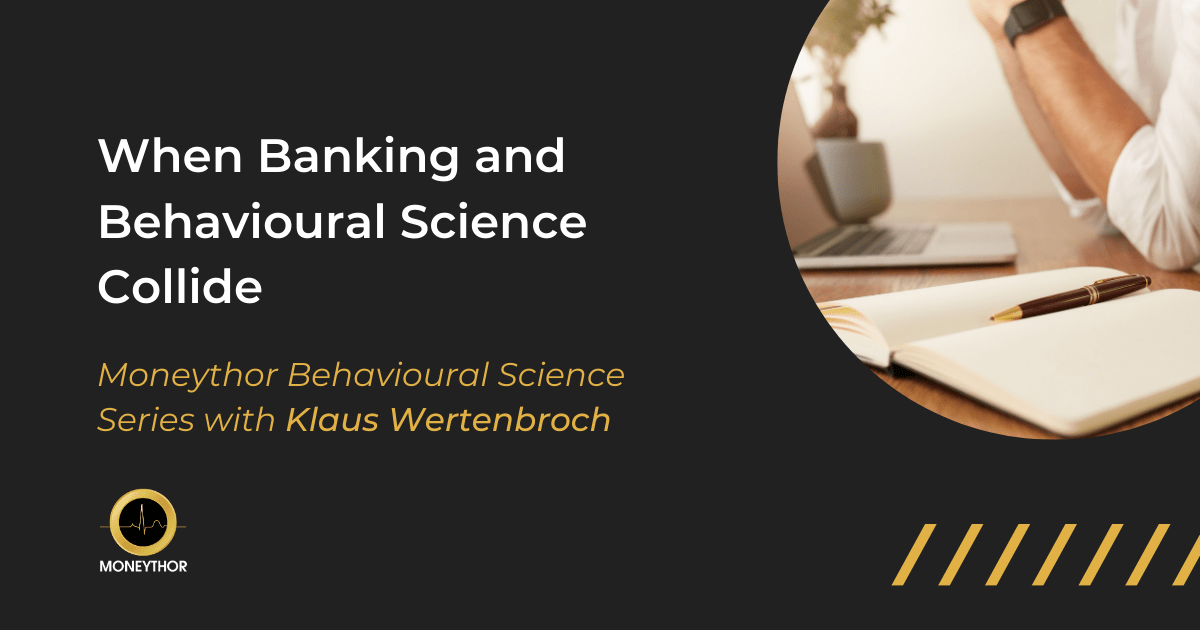Moneythor Behavioural Science Series with Klaus Wertenbroch.
Moneythor’s behavioural science series, a four-part collection of blogs, is based on interviews held with Klaus Wertenbroch, a renowned expert in behavioural economics and consumer-decision-making. In this series we will be delving into the topic of behavioural science in financial services, it’s benefits and pitfalls, the impact it can have on the financial wellbeing of customers and the role it will play in the future of banking.
Part 1 – When Banking and Behavioural Science Collide
At its core, behavioural science is about how people make decisions and the internal and external factors that can influence them. In the last number of years, banks have begun to take behavioural science seriously, building customer experiences and journeys that have common behavioural science techniques as their base and applying these techniques to positively influence the decisions that customers make about their finances.
What role has behavioural science played in the banking industry in the past?
Today’s banks use behavioural science to create experiences that engage, educate and support customers but that was not always the case. When asked about the role of behavioural science in banking in the past, Wertenbroch notes that “Historically the financial services industry has not relied too much on behavioural science, other than perhaps in designing advertising campaigns. The prevailing worldview in financial services, reflected in many financial products and also in how the industry is regulated, has been that customers are broadly rational. Armed with sufficient product information, customers make rational decisions about their finances.”
It is criticism of the idea of rational decision-making that led to the birth of behavioural science in banking which proposes that it is unrealistic and over-simplified to assume that people always make rational decisions. People rarely have the full information or the ability to effectively analyse their options. While banks may not be using the “official” behavioural science terms like priming, framing and nudging, product managers in banks have always understood the concept “for example, if you raise someone’s credit limit, they will likely spend more even if they cannot afford to. And because they may not pay off their credit card balances in full, they’ll provide a steady, profitable stream of interest charges” Wertenbroch notes.
Not only have product managers in banks understood basic psychology for the purpose of driving revenue, but they have also “invented tools to help consumers rein in excessive spending. Saving for the future is difficult in the face of tempting opportunities to spend in the present so banks created fixed deposit accounts. Behavioural scientists can explain the underlying psychology, but they didn’t invent these well-established financial products.”
Why has behavioural science become a common tool for modern banking?
“Using behavioural science to gain insight into financial behaviour really gained traction with the Nobel Prize in economics for psychologist Daniel Kahneman in 2002 for his work on human judgement and decision-making. His research with his fellow psychologist Amos Tversky spawned the development of a new field in economics, behavioural economics, which studies how people’s decisions systematically deviate from rationality. One of the key protagonists in this new field is [Richard] Thaler . . . who won the Nobel Prize in 2017,” says Wertenbroch.
In addition to the impact that increased research and study into behavioural science has had in the banking industry, according to Wertenbroch, technology has played a big role in its adoption in banking and application in real-life. “Behavioural economics lays the groundwork for using behavioural insights in banking. That is facilitated by technology which now allows customers to manage their finances more actively and easily and allow banks to provide more touchpoints.”
“At a very basic level, appealing to the rational side of customer decision-making, banks . . . provide information to their customers about products or warnings about how to avoid falling prey to phishing and other types of fraud.” While this is useful for customers, digitalisation is allowing banks to do more than that.
“Technology offers many more opportunities to create value for banking customers now. For starters, banks have lots of data about their individual customers’ financial behaviour. This allows them to personalise their offers and services at scale. Such a high degree of personalisation was previously possible only for private banking customers. With personalisation at scale modern banking can benefit from systematically relying on behavioural science to create customer value.”
But technology alone cannot fully comprehend a customer’s needs and without an understanding of customer behaviour could lead to issues in the future. “For example, banks and other financial intermediaries that rely on algorithms routinely fail to explain to their customers why they reject some financial transactions. In the future, some of these algorithms may become so complex – or “unexplainable” – that humans won’t be able to understand anymore how they operate.”
Wertenbroch notes that there are ways to mitigate these issues. “In one of our current research projects, my colleagues and I show that simple, costless explanations for why – rather than how – customers were rejected can go a long way toward mitigating damaging relationships with customers who were denied by such complex technology. That’s because providing an explanation conveys to customers that the bank is treating them fairly.”
Without the application of behavioural science, personalised messages and recommendations are less effective at sustainably modifying customer behaviour. For banks that want to build customer bases that are engaged, educated and financially secure, a combination of modern technology, personalisation and an understanding of behavioural science are key.
Check out part 2 of the series here
About Klaus Wertenbroch
Klaus Wertenbroch is a Professor of Marketing and Novartis Chaired Professor of Management and the Environment at INSEAD, one of the world’s leading and largest graduate business schools. Wertenbroch is an expert in behavioural economics and consumer-decision-making.


